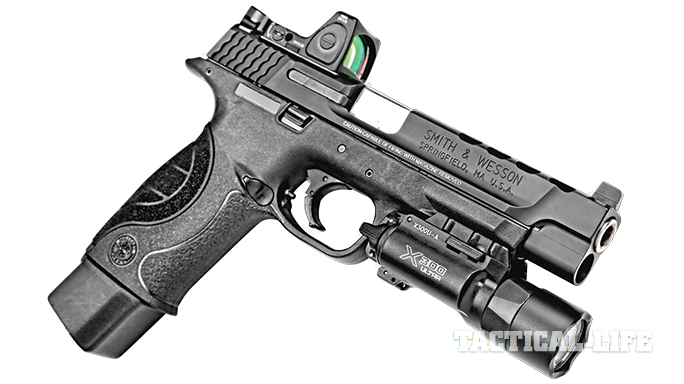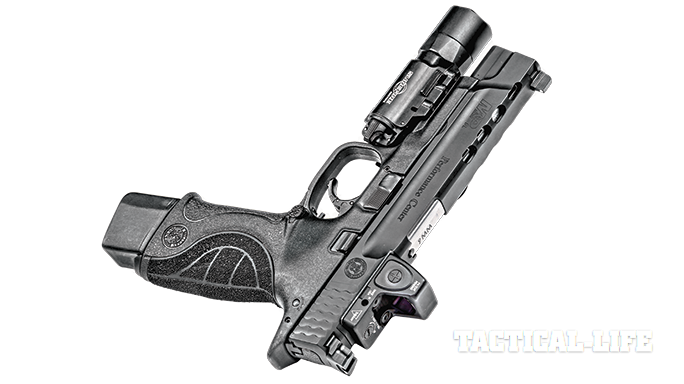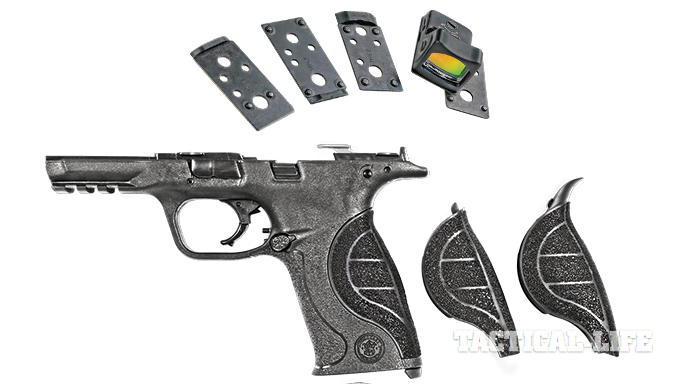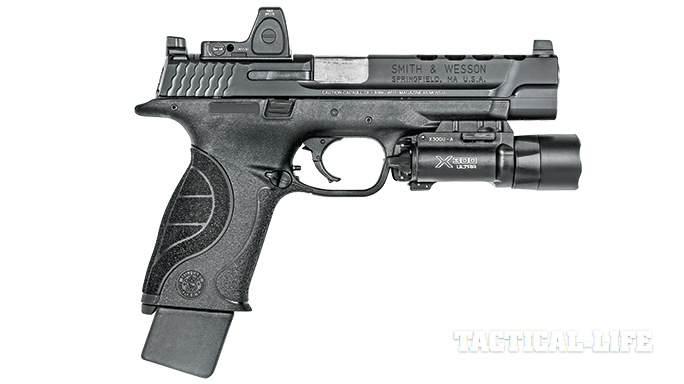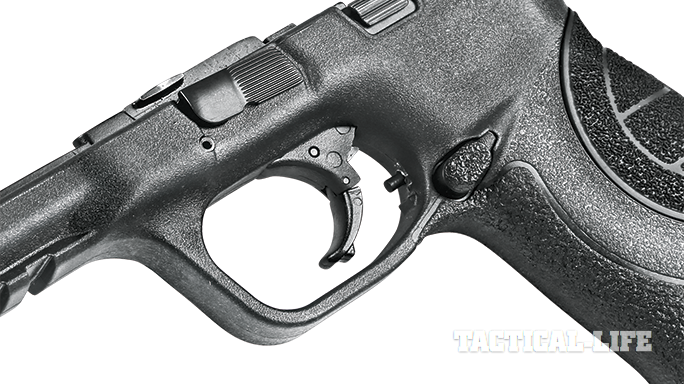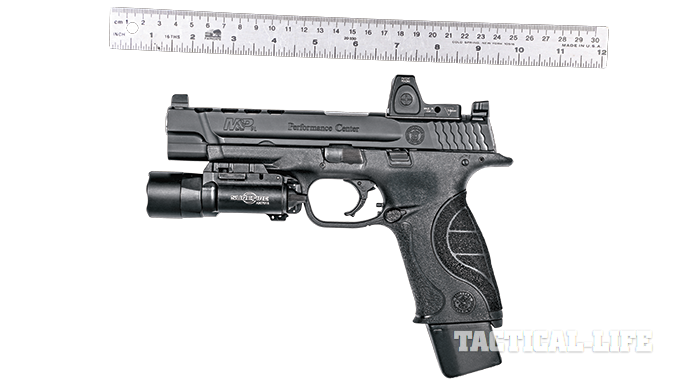When shooting at a pistol competition, time and accuracy are of the utmost importance. Rapid target identification and quick and precise repeated fire on a target’s center “A-zone” nets you the best possible score. In home defense scenarios, time and accuracy are also important factors. Smith & Wesson created its 5-inch M&P9 Performance Center Ported (M&P9 PC Ported) to increase the performance of its M&P line of pistols so that they can be shot at competitions, straight out of the box. Does this increased performance translate into the home defense realm?
- RELATED STORY: Gun Review: Smith & Wesson’s M&P R8 Revolver
Conventional wisdom rules out a tailor-built competition handgun to fill the role of a home defense pistol. Custom-modified race pistols often ride the ragged edge of ultimate performance to the point that they can sometimes sacrifice reliability. This is much like how a finely tuned racecar is capable of astonishing performance on the track, but wouldn’t last a day chugging along in gridlock to and from your work.
Raceguns also usually have a very light trigger, which may not be welcome when adrenaline is coursing through your veins, making your heart race at what feels like 500 beats per minute. In such a stressed state, your fine motor skills become an afterthought. These are all valid arguments against using a high-performance competition gun for home defense.
Advertisement — Continue Reading Below
With all that in mind, a couple of questions arise. When the lives of loved ones are on the line, wouldn’t you rather have a pistol that can give you every advantage over the bad guy? If you were given the choice of defending yourself and your family with a run-of-the-mill pistol or one that has been worked over to run faster and more accurately, which would you choose? What if a commercially available pistol can deliver some of the positive attributes of a racegun without the shortcomings?
Top End
The M&P9 Performance Center Ported is based on the five-inch-barreled, long-slide version of the popular striker-fired, polymer-framed M&P9 pistol, but features a few upgrades performed by the folks at Smith & Wesson’s Performance Center. Engineered with competition shooters in mind, the ported M&P9 is easy to spot at a glance due to its polished stainless barrel and the slide’s lightening cuts. It’s no custom racegun, but we’d say that it’s inspired by the same performance features, bundled in a factory-reliable package.
Advertisement — Continue Reading Below
If you look carefully at the two slots cut into the slide closest to the muzzle, you’ll notice that the barrel is ported as well. The two ports at the end of the barrel help keep muzzle rise down by channeling the escaping gas of a fired cartridge upward and outward as the bullet travels out of the barrel, helping push the muzzle down. The gasses escape in a V formation from the top of the slide.
Trigger Work
In the years since the M&P’s release, aftermarket companies such as Apex Tactical and even Smith & Wesson itself have steadily enhanced the M&P trigger in a variety of ways. This most recent version of the trigger by S&W’s Performance Center on the M&P9 PC Ported features an improved “Performance Center Sear” that is said to give the shooter a quicker and more defined trigger reset.
Advertisement — Continue Reading Below
The Performance Center trigger feels smoother and not at all like the older generation of triggers. The product description for the M&P9 PC Ported on S&W’s website listed a pull weight range between four and five pounds. We measured it at a consistently smooth six pounds. To further enhance this pistol, the engineers at S&W added an adjustable trigger stop just behind the trigger. The trigger stop on the M&P9 — essentially a long setscrew threaded into the frame — adjusts through the rear of the frame with an Allen wrench when the grip’s backstrap is removed. The trigger stop is used to stop the trigger’s rearward movement after the trigger break, resulting in less overtravel, which in turn leads to a quicker trigger reset. When each of the M&P9 PC Ported’s enhancements works in unison, it equates to fast and controllable follow-up shots.
C.O.R.E.
Out of the box, you’ll notice that the M&P9 is equipped with tall suppressor-style iron sights. This is unusual for a pistol that doesn’t come equipped with a threaded barrel for a sound suppressor attachment. A closer look reveals that the top of the slide is pre-milled to accept a mini-red dot sight (MRDS) without needing custom gunsmithing. S&W calls this feature C.O.R.E., or Competition Optics Ready. Specific C.O.R.E. M&P pistol models are also available without the M&P9 PC Ported’s other enhancements. The raised three-dot sights are meant to co-witness with an MRDS if you choose to use one.
Advertisement — Continue Reading Below
You can expose a space that can accept a number of optics by removing the two screws attached to the plastic panel. The M&P9 PC Ported comes with five C.O.R.E. adapter plates along with a number of screws that can attach the MRDS. S&W recommends six optics compatible with the adapter plates, including the Trijicon RMR, Leupold Delta Point, JPoint, Doctor, C-More STS and Insight MRDS. We also took it upon ourselves to mount a Burris FastFire 3, unofficially increasing the compatibility list to seven optics.
MRDS’s have become a hot topic in the shooting world over the past couple years. They were originally used almost exclusively on competition guns, gradually spreading into tactical circles as well. Early MRDS models were unreliable and fragile enough that most tactical shooters stayed away from them. As optics technology improved, so too did their reliability and robustness. The tactical world took notice and started to experiment by training with them. Nowadays, the idea of having a red dot on a tactical or defensive pistol usually attracts an equal number of proponents and detractors. In any case, it’s a concept worthy of further investigation, as the option of adding an optic on top of this pistol without any custom work is a bonus in our books.
Aggressive Grip
Advertisement — Continue Reading Below
Like most others in the M&P pistol line, the M&P9 PC Ported comes with three different-sized interchangeable backstraps to help better conform the pistol to the shooter’s hand. The backstraps are labeled small, medium and large and are designed to fit a variety of hand sizes.
This system of backstraps along with the pistol’s grip contour has worked well for S&W and has helped make the M&P a favored gun for shooters who like its ergonomic and custom fit. Some shooters further modified their grips by stippling them for increased grip. S&W addressed this need by including backstraps on this pistol with a more aggressive texture on their palm swells. We really like the feel of it, and only wish that the rest of the grip got the more aggressive treatment.
Accessories
Advertisement — Continue Reading Below
We added a SureFire X300 Ultra LED WeaponLight to the frame’s Picatinny rail. The X300 Ultra can blast out 500 lumens of eye-squinting light at the cost of only four ounces of weight. For the optic, we went with a Trijicon RMR RM07, which is adjustable for brightness and has a 6.5 MOA dot.
We also used Arredondo Accessories Base Pads that increase the standard magazine’s complement of 17 rounds by five for a total of 22 rounds of 9mm. The extra five rounds probably gave us a few extra seconds of fun time at the range before we had to reload.
Shooting Impressions
Advertisement — Continue Reading Below
We took the M&P9 PC Ported to the range to see if the Performance Center enhancements really made a difference. We are already fans of the regular line of M&Ps and have gotten a considerable amount of time behind both stock and aftermarket modified versions.
We set up a mix of IPSC-style cardboard targets and steel plates at distances ranging from 5 feet to 25 yards. Under time, we ran a course of fire with multiple shooters and evaluated each run for time and accuracy. Ammunition-wise, we tried PMC Bronze 115 grain, Remington UMC 147 grain and Speer Gold Dot Personal Protection +P hollow points with no malfunctions.
We started the session with iron sights with no optic attached. Our first impression was that the pistol wants to keep its muzzle down. Quick double and even triple taps didn’t raise the muzzle much when compared to a nonported M&P9. The barrel’s twin ports seemed to do their job quite well. The sights quickly came back into alignment with the last hole we made in the target.
Advertisement — Continue Reading Below
We were thrown off quite a bit by the gap between the gun’s point of aim and point of impact caused by the raised suppressor sights and the length of the long slide. Most of our shooters hit low at distance, since they were unfamiliar with the set-up. After some more time getting accustomed to it, we eventually got our hits to come in where we wanted them. Surprisingly, the gas expelled from the ports didn’t dirty up the white dot on the front sight as quickly as we though it would. However, it did eventually need a quick wipe off.
The trigger feel is smooth with a clean break and much better than older-generation M&Ps. We cracked off accurate shots at 25 yards with its six-pound trigger pull without problem. Even equipped with the Performance Center sear, the trigger’s reset feel isn’t as clearly defined as what you would get from an aftermarket kit, but we feel it’s an improvement over the previous factory Smith & Wesson triggers that we’ve tried. We adjusted the trigger stop to the point where there was virtually no overtravel. This helped us get shots off in repeated succession while staying on target.
We then slapped a Trijicon RMR on top of the slide. One of our shooters was well versed in shooting with red dots on pistols, while the rest of us weren’t as experienced, usually keeping our red dots on rifles. The experienced shooter had no problem transitioning from iron sights to the RMR and was faster through the course of fire than without it. It was a different story for the rest of the shooters, however. It’s easy to get lost trying to find the red dot when you’re not accostomed to using one, especially if you’re running and gunning on a dynamic course. But as we kept using it, all of us got faster and faster with it. Once you get the hang of it, the RMR is really quite fun. Co-witnessing the RMR with the raised iron sights wasn’t a problem.
Ported in the Dark
In the context of using an enhanced performance pistol for home defense, we went to a range where we could control the lighting. Since many home defense situations occur at night, we wanted to see how the blast from a ported barrel affects one’s natural night vision. A prevalent view is that ported barrels blind their user’s night vision. We wanted to find out if this was true with the M&P9 PC Ported.
For comparison, we shot the M&P9 PC Ported, a full-sized 4.25-inch M&P9, a 1911 in .45ACP and a revolver in .38 Special in both low-light and complete darkness. Since firing most any nonsuppressed gun at night will produce a flash at the end of it, this experiment was all about relativity and not absolutes.
After our eyes adjusted to the low-light setting, we proceeded with the test. We fired the 4.25-inch M&P9 first, and then moved on to the Ported, followed by the 1911 and finally the revolver. We took enough time for our eyes to readjust after every handgun change and light setting variation. Suffice it to say, we were seeing spots after all was said and done.
If we assigned numbers to a blast’s brightness, the full-sized M&P9 would register at 5, the Ported at 7 and the 1911 and a revolver both at 10 or even 10-plus. So yes, the ported barrel of the M&P9 PC Ported is brighter than a nonported M&P. But the ported M&P’s muzzle flash isn’t nearly as blinding when compared to a 1911 and revolver (both likely very common home defense guns).
For those who don’t want to shoot in darkness, there’s the option of using a flashlight to positively identify the target before shooting it. With the SureFire X300 Ultra on, the ported barrel’s flash was completely negligible.
Conclusion
With its improved trigger, customizable grip sizing, C.O.R.E. optics capability, lightened slide and ported barrel, Smith & Wesson’s Performance Center has taken an already solid performer and refined it to be an even smoother shooter. It’s a great choice for those who are looking for a turnkey solution to get into competition shooting – or for those who want to add to their M&P collection (yours truly, guilty as charged).
- RELATED STORY: Gun Review: Smith & Wesson M&P Bodyguard 380
While the M&P9 Performance Center Ported was not made with home defense expressly in mind, its improved performance aspects are interesting to consider for the role. Why wouldn’t you want to give yourself every available advantage when defending your home and loved ones? That’s a question you’ll have to answer for yourself. But if it were up to us, we’d take a
good hard look at it.
For more information on the M&P9, please visit Smith-Wesson.com.
